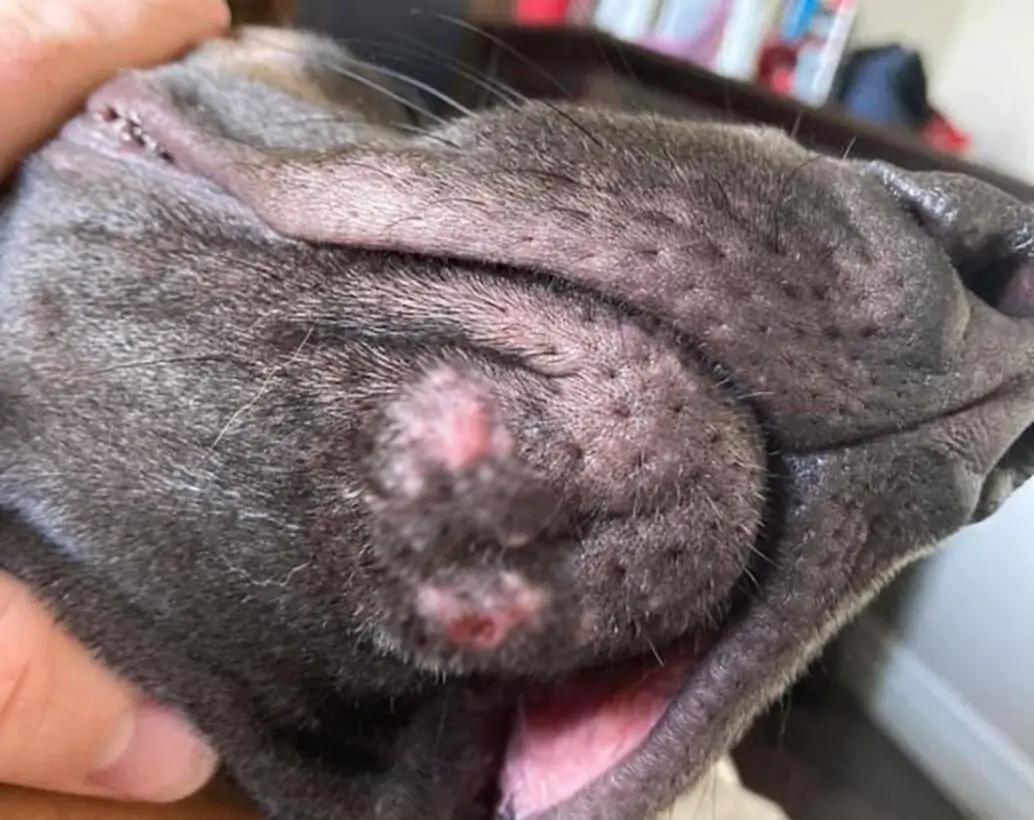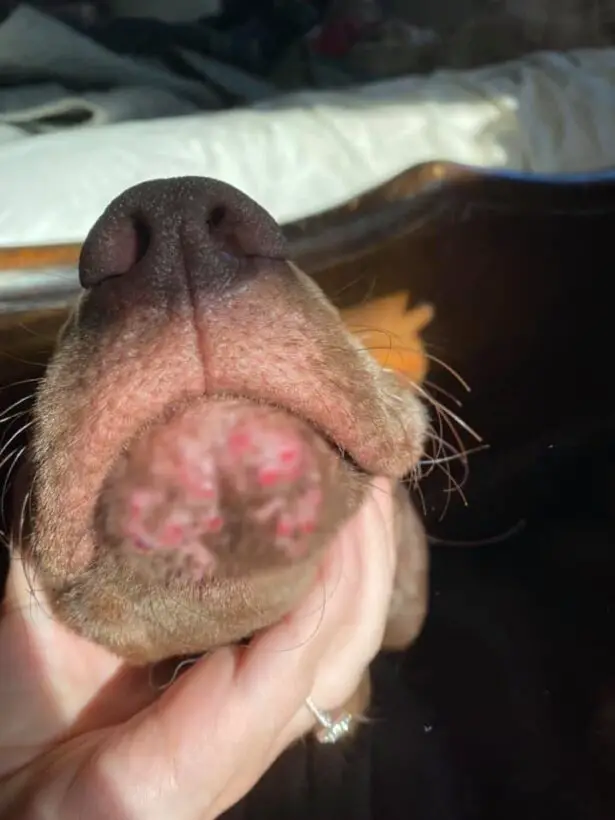Acne on a dog’s chin is a fairly common condition that can affect dogs of all breeds and ages. It manifests as red bumps or blackheads, typically around the dog’s chin and lip area.
While it might seem alarming, canine acne is usually not a serious condition and is often related to the natural oil production in a dog’s skin.
- Key Takeaway
- What is Acne On a Dog’s Chin?
- Causes of Chin Acne in Dogs
- Symptoms of Chin Acne In Dogs
- Diagnosis of Chin Acne in Dogs
- Treatment For Chin Acne In Dogs
- Recovery of Chin Acne in Dogs
- How To Prevent Chin Acne in Dogs
- Common Dog Breeds That Get Chin Acne
- Is It OK To Pop a Dog’s Pimple?
- FAQs
- In Conclusion
Key Takeaway
- Acne on a dog’s chin is a skin condition characterized by red bumps or blackheads typically around the chin and lip area, caused by factors such as hormonal changes, stress, or poor hygiene.
- The causes of chin acne in dogs can include trauma to the skin, genetic factors, environmental causes, underlying conditions like demodicosis and furunculosis, contact irritation, and clogged pores due to dirt, debris, and excess sebum.
- Symptoms of chin acne in dogs include red bumps or pustules on their skin, swelling of the lips or muzzle, hairless areas, excessive rubbing or scratching of the affected area, and in severe cases, inflammation, facial swelling, bleeding, and discomfort.
- Treatment for chin acne in dogs typically involves the use of topical benzoyl peroxide to flush out the hair follicles and reduce bacterial contamination, along with possible dietary changes, behavioral therapy, oral or topical antibiotics, and in some cases, antibacterial and medicated shampoos, as advised by a veterinarian.
What is Acne On a Dog’s Chin?

Acne on a dog’s chin, often referred to as canine acne, is a skin condition that can cause red bumps (pustules) and blackheads (comedones) to appear on a dog’s skin, typically around the lip and chin area.
It’s usually seen in younger dogs, especially large-breed puppies.
While it’s typically not a serious condition, canine acne can cause discomfort and may lead to secondary infections if left untreated.
Causes of Chin Acne in Dogs
- Hormonal Changes: Similar to human acne, hormonal changes especially during puberty can cause acne in dogs.
- Poor Hygiene: Lack of regular grooming can lead to oil and dirt buildup on the skin, causing acne.
- Plastic Food Bowels: Plastic bowls can harbor bacteria which can cause acne. Using stainless steel or ceramic bowls is recommended.
- Trauma to the Skin: Any kind of trauma or damage to the skin can cause inflammation leading to acne.
- Allergies: Allergic reactions to certain foods, dust mites, or other environmental factors may trigger acne.
- Immune System Disorders: Some immune system disorders can lead to skin problems, including acne.
- Stress: Just like in humans, stress can also lead to breakouts in dogs.
Symptoms of Chin Acne In Dogs
- Red Bumps: These are often the first signs of canine acne and may appear as small red bumps on the dog’s chin, lips, or muzzle.
- Blackheads: Just like humans, dogs can also get blackheads (comedones), which are typically seen on the chin and lower lip.
- Swelling: The affected area may appear swollen or inflamed.
- Pus-filled Lesions: In severe cases, the bumps may become pus-filled and may rupture, leading to possible secondary infections.
- Hair Loss: Some dogs may experience hair loss in the area affected by acne.
- Discomfort or Pain: Canine acne can cause discomfort or even pain, especially when touched.
- Itching: The dog may scratch or rub its face against objects due to itchiness.
Diagnosis of Chin Acne in Dogs

The diagnosis of chin acne in dogs often involves several steps:
Clinical Examination
The first step in diagnosing chin acne in dogs is a thorough clinical examination by a veterinarian. The vet will examine the dog’s skin, particularly focusing on the chin, lips, or muzzle area where acne typically occurs.
Rule Out Other Conditions
Before confirming the diagnosis of canine acne, the vet will likely rule out other possible causes of the symptoms observed. These could include conditions like demodicosis (a type of mange), ringworm fungus, eosinophilic folliculitis, furunculosis, and contact irritation.
Observation of Symptoms
The vet will look for common symptoms of canine acne. These include swelling of the lips or muzzle, pimples on the chin, lips, or face, and excessive rubbing or scratching of the affected area. Red bumps, blackheads, and inflamed hair follicles are also common signs.
Potential Additional Tests
In some cases, additional tests may be needed to confirm the diagnosis. This could include skin scrapings or biopsies to rule out other skin conditions, or to confirm the presence of bacteria that can cause acne.
Once a diagnosis of canine acne is made, the vet will recommend a treatment plan tailored to the severity of the condition and the individual dog’s needs.
Treatment For Chin Acne In Dogs
Treating chin acne in dogs includes:
Consult a Veterinarian
First and foremost, if your dog is showing signs of chin acne, it’s crucial to consult a veterinarian for a proper diagnosis. They may prescribe topical or oral medications based on the severity of the condition.
Administer Prescribed Medications
Once your vet has prescribed medication, administer it as directed. This could include topical treatments like creams or gels, or oral antibiotics. Some vets may prescribe steroids to reduce inflammation. Always follow the vet’s instructions closely and complete the full course of medication even if symptoms seem to improve.
Implement Dietary Changes
In some cases, dietary changes may be recommended by your veterinarian. Certain foods can cause allergic reactions resulting in skin conditions like acne. Switching to a hypoallergenic diet or eliminating certain foods may help alleviate the symptoms.
Improve Hygiene Practices
Regular grooming is essential in managing canine acne. This includes regular baths with medicated shampoos that have antibacterial properties. These can often be purchased from your local pet store.
Use Topical Treatments
Alongside prescribed treatments, certain over-the-counter topical treatments can also be used to help heal canine acne more quickly. Always consult with your vet before starting any new treatment.
Removal of Irritants
If the acne is being caused by an irritant, such as plastic food bowls, it’s important to remove these from your dog’s environment. Switch to stainless steel or ceramic bowls instead.
Monitor Progress
Finally, monitor your dog’s progress closely. If the acne does not improve or worsen, it’s important to revisit the vet for further consultation. In some cases, further treatment or adjustments to the current treatment plan may be needed.
Recovery of Chin Acne in Dogs
The recovery of chin acne in dogs generally involves a combination of treatments and preventive measures.
Common treatments include topical applications like benzoyl peroxide (check prices on amazon.com), which helps flush out the hair follicle and reduce bacterial contamination.
Other topical medications such as mupirocin 2% or benzoyl peroxide gel may also be used to prevent relapses.
In some cases, veterinarians may prescribe oral medications, medicated soaps, or even recommend a change in diet.
It’s essential to follow your vet’s directions closely for the best outcome. Over-the-counter shampoos and ointments can also help manage canine acne. However, long-term preventive care may be necessary to avoid a relapse.
How To Prevent Chin Acne in Dogs
Here is how to prevent chin acne in dogs:
Maintain Good Hygiene
Regularly clean your dog’s face, especially after meals. Use a soft cloth or dog wipes (order from amazon.com) to gently wipe their muzzle. This helps remove any food particles or debris that could clog their pores.
Use Topical Treatments
Consult with your vet about suitable topical treatments for your dog. These can include medicated wipes, ointments, and shampoos. A 2% benzoyl peroxide cream can also be used for mild cases.
Keep Your Dog Dry
After swimming or bathing, make sure to thoroughly dry your dog’s face. Excess moisture can contribute to the development of acne.
Brush Their Teeth Regularly
Regular dental hygiene can help prevent bacteria from spreading to your dog’s chin, reducing the chances of acne.
Clean Toys and Bowls
Regularly clean your dog’s toys and food bowls to prevent bacteria build-up. If you’re using plastic bowls, consider switching to metal or ceramic options as plastic can harbor bacteria and cause irritation.
Consider Dietary Changes
In some cases, diet can contribute to canine acne. Consult with your vet about potential dietary changes that could improve your dog’s skin health.
Regular Vet Check-ups
Regular vet check-ups can help detect early signs of acne and other skin conditions. Your vet can provide professional advice and treatments to prevent the progression of acne.
Common Dog Breeds That Get Chin Acne
- American Bulldogs
- Boxers
- Great Danes
- Rottweilers
- Dobermans
- Other short-coated breeds
- Many brachycephalic breeds (those with short noses and flat faces)
Is It OK To Pop a Dog’s Pimple?
No, it’s not recommended to pop a dog’s pimple because it can lead to more inflammation and potentially cause an infection.
It can also be painful for the dog. Instead, it’s best to seek advice from a veterinarian who can provide appropriate treatment options.
They might prescribe topical creams or oral medications to help reduce inflammation and treat the acne.
Maintaining a clean environment for your pet and ensuring they have a balanced diet can also help prevent future breakouts.
FAQs
Q: Can dogs get acne like humans?
A: Yes, dogs can get acne, but it is different from human acne. Canine acne is typically localized to the chin and muzzle area, while human acne can occur on various parts of the face and body.
Q: Can I treat my dog’s acne at home?
A: It is recommended to consult with a veterinarian for proper treatment of dog acne. While some mild cases can be managed with home remedies, it is best to get a professional diagnosis and guidance to ensure proper and effective treatment.
Q: Can canine acne be a sign of a more serious condition?
A: In some cases, canine acne can be a symptom of an underlying condition, such as demodicosis or pyoderma. If the acne persists or worsens despite treatment, it is important to have your dog evaluated by a veterinarian to rule out any other potential health issues.
Q: Can canine acne rupture or become itchy?
A: Yes, canine acne can rupture, leading to the formation of pustules and possible bacterial infections. It can also cause itching and discomfort for the dog. Proper treatment can help alleviate these symptoms.
Q: How can I prevent canine acne?
A: While it may not be possible to completely prevent canine acne, you can help your dog by maintaining proper hygiene practices, using stainless steel or ceramic bowls instead of plastic, and keeping their chin and muzzle area clean and dry.
In Conclusion
Acne on a dog’s chin, also known as canine chin acne, muzzle folliculitis, or furunculosis, is an inflammatory disorder that typically appears in the form of red bumps, hairless areas, and potentially pus-filled bumps on the lower lips, muzzle, and chin area.
It’s most common in young dogs and is usually a normal symptom of puberty, although there can be other contributing factors. Treatment options range from preventative measures to topical solutions and antibiotics, as advised by a veterinarian.





Leave a Reply